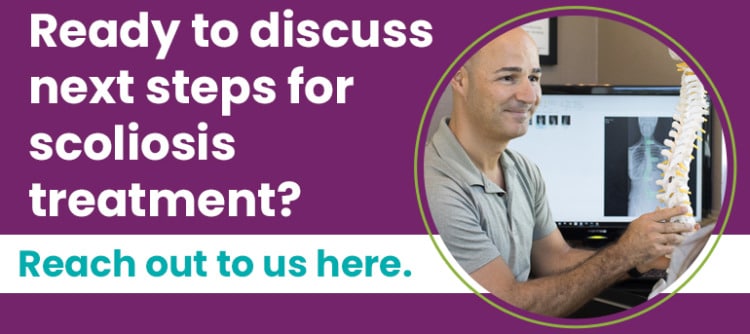Bulging Disc Support: Massage for Scoliosis Relief
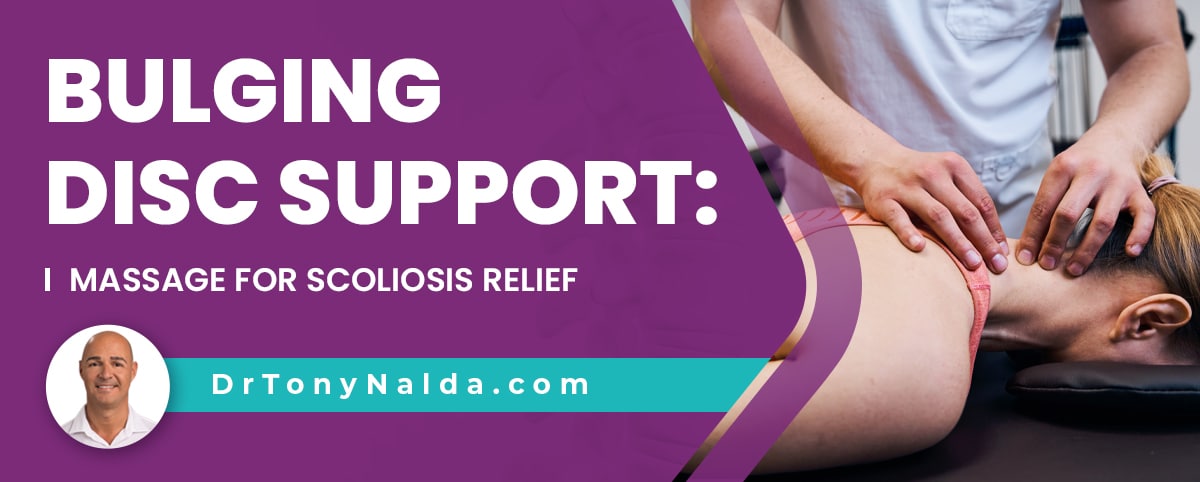
Scoliosis causes the spine to bend and twist unnaturally, but its effects can be felt throughout the body. Scoliosis affects the spine, all of its parts, and its surrounding muscles and nerves. A disc sits between adjacent vertebrae and can be impacted by scoliosis in different ways.
Scoliosis can contribute to disc issues because of uneven forces and wear and tear on the spine. While massaging a bulging disc and its surroundings can bring temporary pain relief through relieving muscle tension and improving circulation, it does nothing to reverse the bulging disc.
Table of Contents
Anatomy of the Spine
The spine is one long complex structure, and while it has three main sections with distinct purposes, the health of a single section can affect the health of the entire spine.
If one spinal section loses its healthy curves, the spine has become misaligned, and this means uneven forces felt throughout the spine.
The spine consists of the cervical spine (neck), the thoracic spine (middle/upper back), and the lumbar spine (lower back).
The spine consists of vertebrae (bones of the spine) and adjacent vertebrae are separated by an intervertebral disc.
The discs perform several functions that shape the spine's health and function.
Intervertebral Discs
An intervertebral disc has two main structures: a soft inner core known as the nucleus and a hard durable outer layer known as the annulus.
The discs act as the spine's shock absorbers, provide cushioning between adjacent vertebrae to prevent friction during movement, combine forces to facilitate the spine's flexibility, and give the spine structure (adjacent vertebrae attach to the disc in between).
As we age, the body is subject to degenerative changes, and the spine is no exception.
Most spinal degeneration starts with the discs.
What is a Bulging Disc?
A bulging disc occurs when a disc's inner nucleus is pushing against its outer annulus causing the disc to bulge outwards into its surroundings.
If a disc changes shape and bulges outwards, it's taking up more space than it should, and that space within and around the spine can feel the effects in different ways.
A bulging disc can become a herniated disc if the bulging causes a tear in the outer annulus through which the inner nucleus protrudes; disc herniation puts even more pressure on its surroundings.
How Does Scoliosis Contribute to A Bulging Disc
As scoliosis causes the spine to bend and twist unnaturally, it's exposing the spine and its surroundings to a lot of uneven forces, and those uneven forces can contribute to uneven wear and tear on the spine, and this can cause excessive degenerative changes.
While most degenerative changes are age-related, the cumulative effects of a certain lifestyle factors also play a role in a person's level and rate of spinal degeneration.
Discs are difficult to repair because they don't have their own vascular supply; in fact, the discs are the largest structures of the body without their own vascular supply.
So the discs have to absorb nutrients and get oxygen from their surroundings.
If scoliosis is causing a bulging disc due to the condition's uneven forces causing disc degeneration, does massage help alleviate pain and related symptoms?
Bulging Disc Pain
Scoliosis isn't always painful, but when it is, it can cause varying levels of pain caused by compression, and this can affect the spine and its surrounding muscles, nerves, and the entire body.
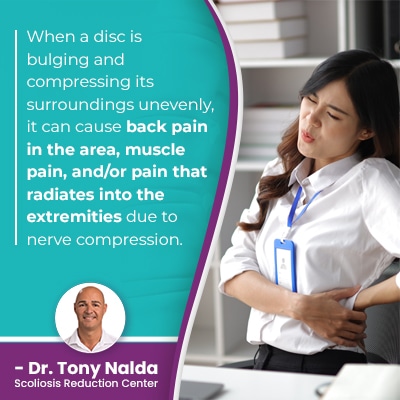 When a disc is bulging and compressing its surroundings unevenly, it can cause back pain in the area, muscle pain, and/or pain that radiates into the extremities due to nerve compression.
When a disc is bulging and compressing its surroundings unevenly, it can cause back pain in the area, muscle pain, and/or pain that radiates into the extremities due to nerve compression.
The area of the body located the closest to a bulging disc is going to feel the majority of the condition's direct effects.
A number of therapies can be applied in the name of pain relief, and massage therapy has been a popular option to deal with back pain for years.
So can massage therapy help bulging disc pain caused by scoliosis?
Massage Therapy and Bulging Disc Pain
When a disc is bulging, it can affect surrounding nerves and muscles. Muscle tension can develop as a result of uneven pressure on a near by muscle, and massage targets the disc and its immediate surroundings.
A massage can help relax a strained muscle, reducing tension, and improving circulation in the area. A sore muscle and a bulging disc can both benefit from increased blood flow for nutrient absorption and repair.
Scoliosis is also associated with the development of a muscular imbalance. The unnatural spinal curve can pull its surrounding muscles in different directions; this can cause the muscles on the one side of the spine to become strained and sore for overuse, while muscles on the opposite side can become weak from lack of use.
A muscular imbalance can also cause muscle tension, muscle spasms, and pain, and massage therapy can help with short-term relief by relaxing tense muscles, but as is the case with a bulging disc, although massage can provide some temporary symptom relief, it's not addressing the cause of the pain, so isn't a permanent solution.
Bulging disc pain can vary from mild and intermittent to chronic pain that's debilitating, but is largely shaped by severity and location of the bulging disc.
Increasing blood flow through massage therapy can help increase the general health of the disc and area.
While massage therapy can provide temporary and natural pain relief, for long term pain relief, treatment that addresses the underlying cause of the bulging disc is necessary.
Bulging Disc Treatment Options
When a bulging disc develops, the first step to healing the affected disc is to determine the cause of the degeneration.
Degenerative disc disease is the main cause of bulging and herniated disc pain, and while the majority of spinal degeneration is natural and age-related, lifestyle factors, injury, and the presence of a spinal condition like scoliosis can also contribute to changing disc health.
When a bulging disc develops due to natural age-related spinal degeneration, physical therapy and lifestyle modification can help improve the health of the affected disc and affected muscles.
Physical therapy can help by increasing circulation and improving posture.
If an overuse injury is the cause of the bulging disc, the injury has to be the focus of treatment, and often rest and deep tissue massage can help with short-term pain relief by relieving muscle tension in the area.
Scoliosis Treatment for Bulging Disc Pain Relief
If the presence of a spinal condition like scoliosis has caused the degeneration that led to the disc degeneration, the scoliosis has to be addressed or the uneven forces causing the excessive degenerative changes will continue.
And as a progressive condition, the nature of scoliosis is to get worse over time, so to preserve disc function and prevent further deterioration, including disc herniation, the scoliosis has to be addressed on a structural level.
Through conservative treatment offered here at the Scoliosis Reduction Center®, patients can experience curvature reductions and core muscle strengthening that can realign the spine and restore balance to the spine and body.
As scoliosis progresses, it's not just the spine that's being affected, but also its surrounding nerves and muscles, so for scoliosis muscle pain, massage can help with tight muscles, reduce muscle spasms, promote relaxation, and relieve pain.
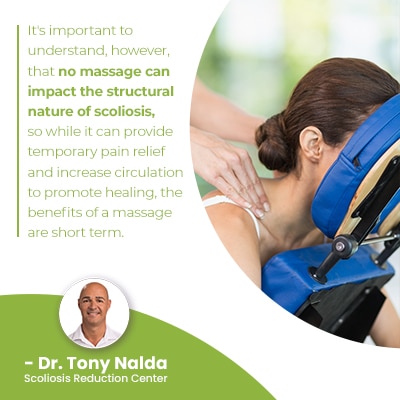 It's important to understand, however, that no massage can impact the structural nature of scoliosis, so while it can provide temporary pain relief and increase circulation to promote healing, the benefits of a massage are short term.
It's important to understand, however, that no massage can impact the structural nature of scoliosis, so while it can provide temporary pain relief and increase circulation to promote healing, the benefits of a massage are short term.
Conclusion
Scoliosis can affect the spine and body in many ways. As an asymmetrical condition that disrupts the body's overall symmetry, it can expose the spine and its parts to uneven forces and pressure.
If the unnatural spinal curve and bend is causing the spine to degenerate and develop a bulging disc, massage therapy and hot and cold therapy can help with temporary pain relief, but it can't be considered a treatment or way to prevent future pain.
Massage therapy can help bulging disc pain by relieving muscle tension and improving blood flow around an affected disc.
Massaging a bulging disc and the affected area can benefit from improved circulation by making oxygen and nutrients needed for repair more readily available to the degenerating disc.
When it comes to scoliosis pain that can involve the muscles, back, and nerves, massage therapy can once again help with short-term pain management, but does nothing to address the underlying cause of the pain: the structural misalignment of the spine.
Here at the Center, patients benefit from a conservative treatment approach that handles pain management proactively by addressing its root cause.
Dr. Tony Nalda
DOCTOR OF CHIROPRACTIC
After receiving an undergraduate degree in psychology and his Doctorate of Chiropractic from Life University, Dr. Nalda settled in Celebration, Florida and proceeded to build one of Central Florida’s most successful chiropractic clinics.
His experience with patients suffering from scoliosis, and the confusion and frustration they faced, led him to seek a specialty in scoliosis care. In 2006 he completed his Intensive Care Certification from CLEAR Institute, a leading scoliosis educational and certification center.
About Dr. Tony Nalda
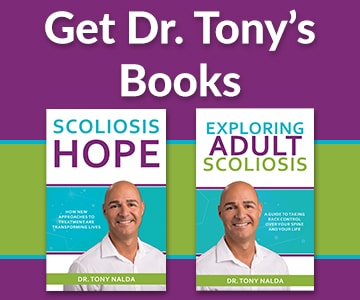 Ready to explore scoliosis treatment? Contact Us Now
Ready to explore scoliosis treatment? Contact Us Now